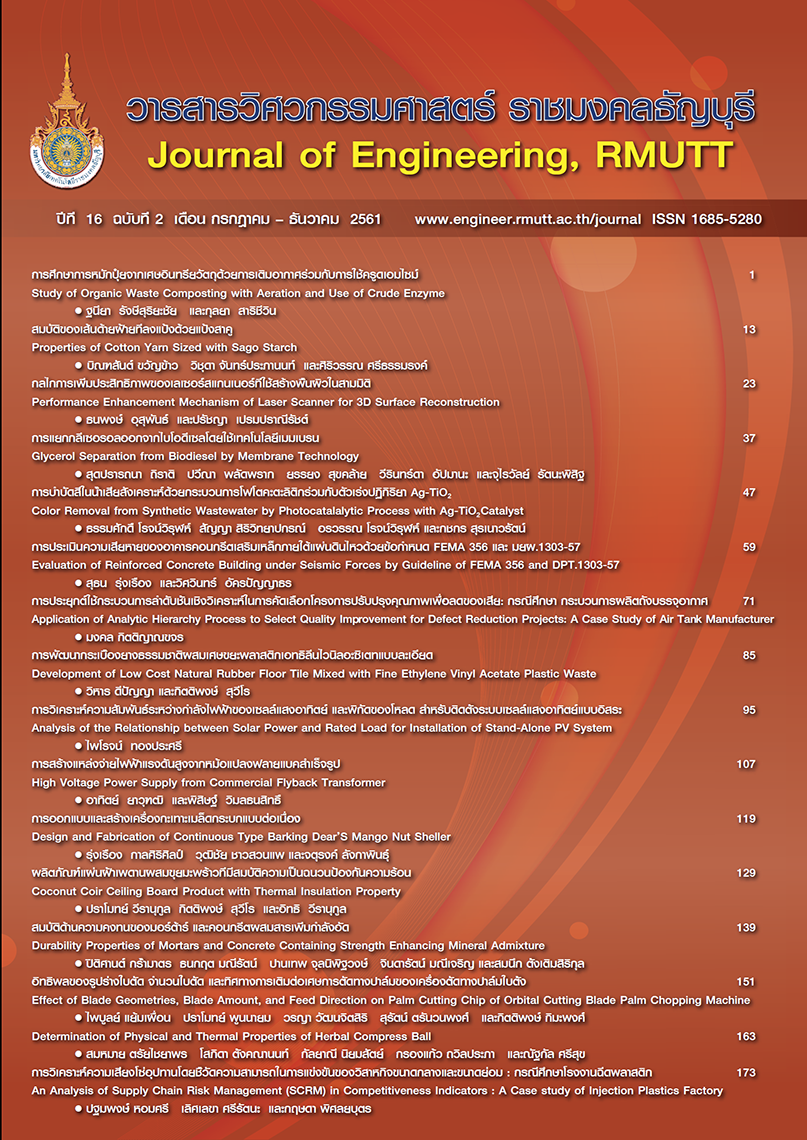Effect of Blade Geometries, Blade Amount, and Feed Direction on Palm Cutting Chip of Orbital Cutting Blade Palm Chopping Machine
Main Article Content
Abstract
One of important factors for increasing palm productivity is an palm residue management. Some palm tree residues such as palm branch and leaf were always cut to small size and then utilized as a fertilizer or a hoof food in a rural area. Therefore, a palm chopping method for utilizing a palm residue was always conducted and developed continuously. This article aimed to select an optimized cutting blade shape, blade amount, and feed direction for cutting a palm branch by an orbital cutting blade palm chopping machine. In this experiment, the designed cutting blades that were produced by a specified condition, were applied for cutting the palm branch using a specified cutting condition. The summarized results are as follows. The cutting lade that made of carbon steel should not apply the tempering after the hardening because it affected to decrease hardness and cutting edge wear. The semi-V cutting blade showed the higher wear resistance and hardness than that of the V cutting blade and indicated hardness of 481 HV and weight loss of 6.24%. The semi-V cutting blade produced higher and larger palm chopping scrap than that of the V cutting blade and could produce the scrap of 3878 g at the cutting speed of 1200 rpm. Increase of the cutting blade amount affected to increase the palm cutting efficiency such as the increase of scrap amount, the decrease of scrap dimension, and the decrease of operation time. Feed direction that inclined to the horizontal axis could decrease a friction force and cutting force between the cutting edge and palm surface and also assisted easily to feed the palm branch.
Article Details
The manuscript, information, content, picture and so forth which were published on Frontiers in engineering innovation research has been a copyright of this journal only. There is not allow anyone or any organize to duplicate all content or some document for unethical publication.
References
Eksomtramage W. and Eksomtramage T. Heritability and Correlations of Argonomic Charaters in Tenera Oil Palm Hybrid. Article Journal of Agriculture. 2553;26: 231-239. (in Thai)
Wikipidia. Palm. Available from: https://th.wikipedia.org/wiki. (in Thai).
Poksawat A., Songkong S. Cutting and Separating Machine Oil Palm Leaves and Fronds Used as Ruminant Animal Feed. Proceeding of the 5th UBU Coference. 2011;August 4-5: 226-234 (in Thai).
Li Y.G., Ye Q, Fan F., Bao Y., and Huang QX. Finite Element Method Analysis of Effect of Blade Clearance on Plate Shearing Process. Journal of Iron and Steel Research, International. 2012;19:26-29.
Aslan S., Coşkun, H., and Kılıç, M. The effect of the cutting direction, number of blades and grain size of the abrasives on surface roughness of Taurus cedar (Cedrus Libani A. Rich.) woods. Building and Environment; 43:696-701.
Kosoom K. Study and Design of Cutting Blade from Rid Residues. Proceeding of the 5th Rajamangala University of Technology Conference. 2014;June 23-25:79-86 (in Thai).
Kimapong K., Poonnayom P.,, and Wattanjitsiri V. Microstructure and Wear Resistance of Hardfacing Weld Metal on JIS-S50C Carbon Steel in Argicultural Machine Parts. Materials Science Forum. 2016;872:55-61.
Kimapong K., Triwanapong S., Prasomthong S., and Wattanjitsiri V. Effect of Buffer layer and Hard-faced Welding on Mechnical roperties of JIS-S50C Carbon Steel Weld Metal. Journal of Engineering, RMUTT. 2016;14:77-90. (in Thai).
Adelaja AO, Dirker J., and Meyer JP. Effects of the thick walled pipes with convective boundaries on laminar flow heat transfer. Applied Energy. 2014;130:838-845.
Hwang B., Suh DW., and Kim SJ. Austenitizing temperature and hardenability of low-carbon boron steels. Scripta Materialia. 2011;64:1118-1120.
McCarthy CT., Hussey M., and Gilchrist MD. On the sharpness of straight edge blades in cutting soft solids: Part I – indentation experiments. Engineering Fracture Mechanics. 2007;74: 2205-2224.
McCarthy CT., Annaidh AN., and Gilchrist MD. On the sharpness of straight edge blades in cutting soft solids: Part II – Analysis of blade geometry. Engineering Fracture Mechanics. 2010;77: 437-451.
Reilly GA., McCormack BAO., and Taylor D. Cutting sharpness measurement: a critical review," Journal of Materials Processing Technology. 2004;153–154:261-267.
Brown T., James SJ., and Purnell GL. Cutting forces in foods: experimental measurements. Journal of Food Engineering. 2005;70:165-170.


